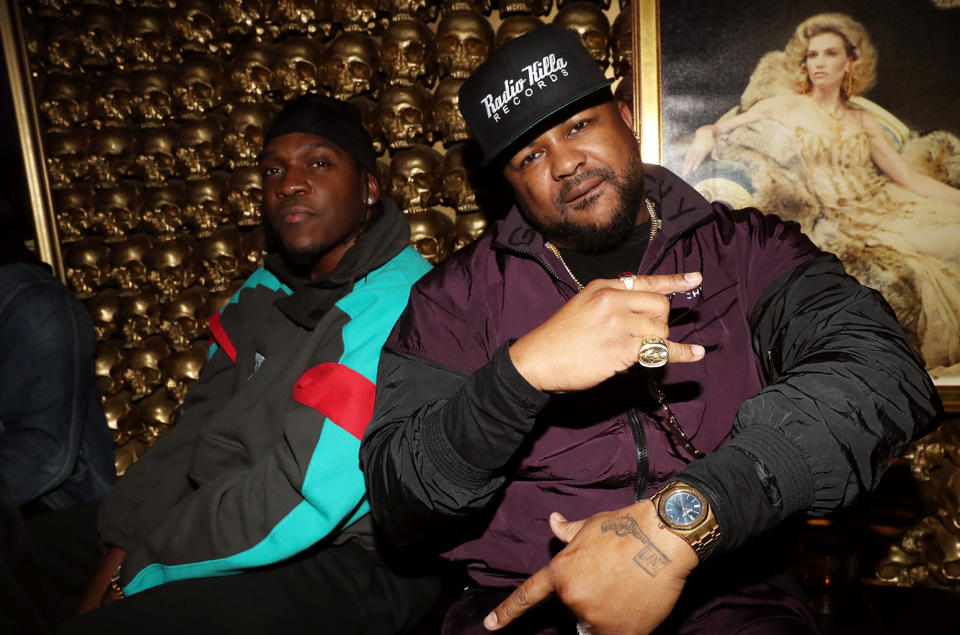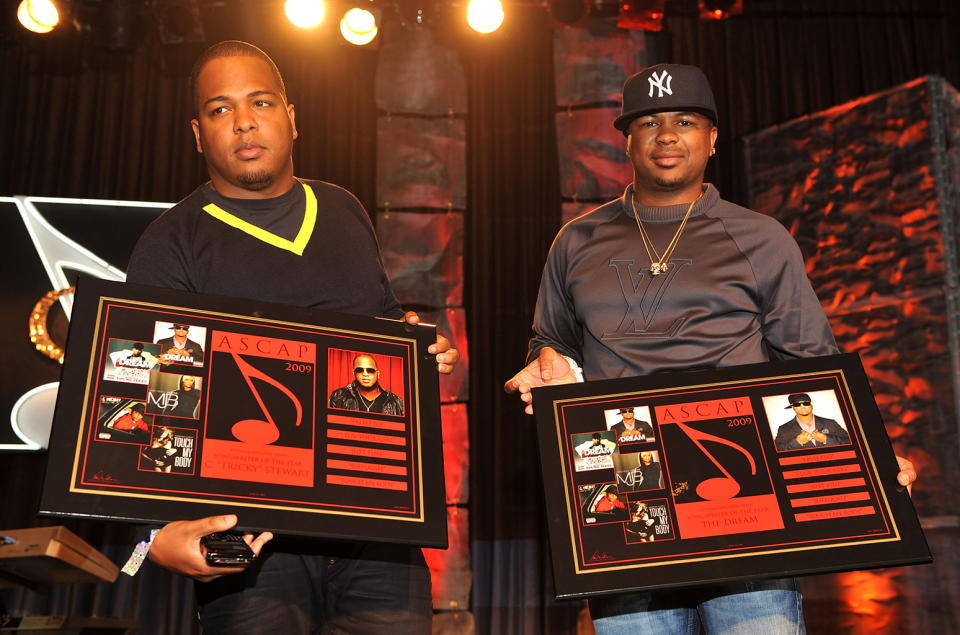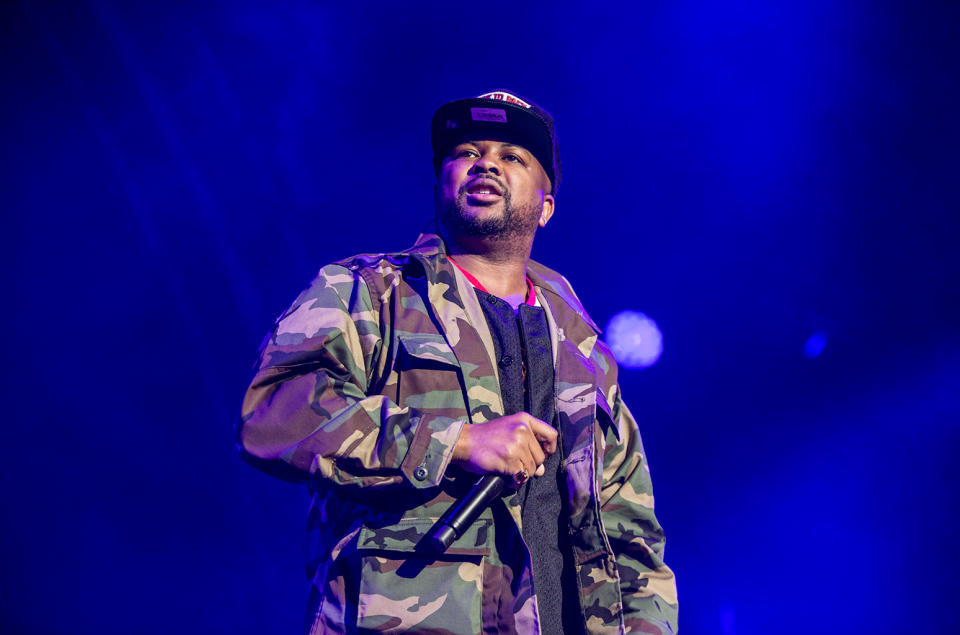Living The-Dream: Beyoncé’s Close Collaborator on a Huge Year & Grammys’ New Songwriting Honor
- Oops!Something went wrong.Please try again later.
- Oops!Something went wrong.Please try again later.
- Oops!Something went wrong.Please try again later.

“ ‘Love is the bridge between you and everything,’ ” Terius Gesteelde-Diamant reads aloud, gesturing to the words scrawled in the corner of an art piece. “Ah!” he claps. “I love it. These quotes are completely amazing.”
The 45-year-old hit songwriter and artist, better known as The-Dream, sighs wistfully as he plops down on a peach-colored velvet love seat, which sits just beneath the artwork. Hung in an ornate gold frame, the piece depicts a group of people intertwined in collective embrace — a painting style reminiscent of Renaissance-era masterpieces — juxtaposed in front of an urban brick wall that’s splattered with various phrases written in technicolor graffiti. The artwork consumes an entire wall of the sitting room in The-Dream’s so-called “art house” in the upscale Buckhead area of Atlanta. Otherwise, the room is completely bare — nothing but tall ceilings and crisp marble floors.
More from Billboard
Jennifer Hudson Celebrates Common's Birthday Amid Romance Rumors: 'One of the Brightest Lights'
SWV Talk 'The Queens of R&B' & Still Being the Same 'Around the Way Girls'
The-Dream adjusts his powder blue bucket hat and peers around his shoulder, back at the phrase. “I like how the longer you think about it,” he says, “the more you realize you don’t fully know what it means.” Its significance is determined by an individual’s perspective and understanding — just like the artwork itself, which he purchased three years ago at Eden Art Gallery in New York. With its hologram surface, its phrases are obscured when entering the room from the left… but from where The-Dream sits on the far right, the portrait shifts, its words clearly revealed.
The-Dream himself has unlocked some of the defining phrases in 21st century popular music, helping to craft smashes like Beyoncé’s “Single Ladies (Put a Ring on It),” Rihanna’s “Umbrella,” Justin Bieber’s “Baby” and Mariah Carey’s “Obsessed,” among many others. He has been present for studio sessions where the meaning of a word has expanded, then permeated popular culture in a different shape. He laughs when reminiscing about Beyoncé’s 2013 self-love anthem “Flawless,” and how he didn’t realize the full impact those eight letters could carry until he saw them needlepointed in scrolling cursive on a throw pillow following its release. “You don’t realize how many people wanted to capture that [feeling] until you see your lyrics on a pillow!” he says.
“This guy just writes a title that, when you read it, you know you have to listen to the song out of curiosity alone,” explains Christopher “Tricky” Stewart, The-Dream’s longtime writing and production partner. “I think he has an unmatched ability to figure out a unique lyrical perspective that can make an artist not only have a hit song, but a song that defines culture and the artist’s career. Something they can build on for the rest of their lives.”
Though The-Dream has been a behind-the-scenes force for the past two decades, he speaks to Billboard on the precipice of a career pinnacle, as evidenced by his presence at the 2023 Grammy Awards. He’s nominated in three of the Big Four categories — record, song and album of the year — for his work on Beyoncé’s seventh solo full-length, Renaissance, and its smash lead single, “Break My Soul.” The acclaimed album, along with his contributions to Pusha T’s It’s Almost Dry and Brent Faiyaz’s Wasteland, also earned The-Dream a nod in the inaugural songwriter of the year, non-classical category, where he will compete against Amy Allen, Nija Charles, Tobias Jesso Jr. and Laura Veltz.

“This means everything,” says Steven Victor — who manages The-Dream in addition to Pusha T, Nigo and others — of the new Grammy category, which he says The-Dream has advocated for for years. To Victor, a great songwriter can embody the points of view of many different types of artists — rap greats like Jay-Z and Pusha T, vocal powerhouses like Carey and Mary J. Blige, pop headliners like Bieber and Britney Spears, four-quadrant superstars like Beyoncé and Rihanna — and shape-shift into them regardless of their genre or personal identity. The-Dream, he vouches, is the best at this in the whole business.
“No one is going to think through these songs more than me,” The-Dream declares. Musical ideas often haunt him through the night, he explains, as more concepts, words and melodies flood his consciousness hours after a studio session ends. His creativity gnaws at him: He recently began attending fashion design classes at the Savannah College of Art and Design (SCAD) and pulls out a collection of expert drawings — a sketch of a clementine, another of a skull.
“I drew a lot as a kid,” The-Dream says with a smile. When asked what he likes to draw most, he shrugs and thinks back to his overall creative approach: “I feel like I’m better when I have an assignment.”
“We had no idea what was happening at the time,” The-Dream says of growing up during the popularization of Atlanta’s music scene in the 1990s, when Southern rap reached the mainstream and acts like TLC and Usher took over pop. “It makes more sense to look back and understand it now.” He recalls watching the success of his neighbor and elementary school classmate T.I. and attending night classes with his pal André 3000 as a teen. “I don’t know what he did or why he was there,” he says with a laugh of the OutKast icon, “but I sure know I was flunking!”
Shortly after some of his acquaintances found musical success in Atlanta, The-Dream signed a publishing deal in 2001 with local mogul Laney Stewart, older brother of Tricky, and scored a writing credit on the B2K song “Everything.” Two years later, The-Dream linked up with Tricky — already producing hits for Mya and Blu Cantrell — and helped create the 2003 Britney Spears-Madonna team-up “Me Against the Music.” “It was explosive to write with him from the very beginning,” says Tricky. The pair complemented each other: Tricky was the perfectionist producer, and The-Dream was the emotive songwriter.
The pair’s brand of rhythmic pop took off in the second half of the decade, with “Umbrella” and “Single Ladies” reaching the top of the Billboard Hot 100 in 2007 and 2008, respectively, and “Baby” making Bieber a teen superstar in 2010. Meanwhile, The-Dream launched his career as an artist, signing with Def Jam and releasing a trio of R&B albums between 2007 and 2010: Love/Hate, Love vs. Money and Love King have earned a combined 2.25 million equivalent album units, according to Luminate.

His recording career has been sporadic since then, his focus constantly pulled back to creating hits for other artists. The-Dream says it’s difficult to define why he’s able to write so clearly about the experiences of others, “but really it’s my job to understand what the artist is going through, even if they don’t understand it yet,” he explains. “ ‘Umbrella’ is a love story, but for some reason, it feels like there is some misery in there too. Like, why do you need to assure this person they can count on you? Maybe, underneath, you know you haven’t had anyone to count on in your life, so you know what it means to be in that place.”
By 2018, the songwriter had turned that approach into one of the most bankable blueprints in popular music: over 70 Hot 100 entries as a songwriter, including 14 top 10 hits and five No. 1s, with 21 career Grammy nominations and five wins. That year, he sold 75% of his catalog, including his writing credits and solo releases, to Merck Mercuriadis’ Hipgnosis for a reported $23 million. It was the song fund’s first-ever catalog purchase.
“I wanted him to be the Dr. Dre to my Jimmy Iovine, if you like,” says Mercuriadis with a grin. “When we look back on the first 25 years of this millennium, I know his songs are going to be the ones people talk about.”
Throughout the 2010s, The-Dream shared the studio with all kinds of artists, but working with women vocalists was always his penchant. In the past, he has spoken about how the early death of his mother, who died of cancer when he was 15, gave him a “soft spot” when interacting with women. “There’s no such thing as a day with no grieving,” he says now, his eyes softening as he looks down at his sneakers.
After his mother’s death, he was put under the watchful eye of his grandfather, a hardscrabble cement mason who grew up in the Jim Crow South. The-Dream fondly recalls the days of listening to his grandfather talking “actively about how to make things well, looking at [them] from all different angles,” over games of pinochle with fellow masons. There’s an invisible throughline, he explains, between the ethos of a master builder, that of an artistic genius like da Vinci, and that of a songwriter like himself.
“When thinking about an artist like Beyoncé, I want to try to consider all the different ways this could reach people,” he says. “I want the song to matter to Beyoncé standing onstage, the person in the front row of the show and that person who’s in the rafters, who barely made it in, got a ticket from a friend last minute. I have to write for each one of them.”

“Single Ladies,” from Beyoncé’s 2008 album, I Am… Sasha Fierce, was the start of a long-term creative partnership and friendship between The-Dream and the superstar, who has tapped the songwriter to help craft at least one song from each of her subsequent albums — “Love on Top” from 2011’s 4, “Partition” from 2013’s Beyoncé and “6 Inch” from 2016’s Lemonade. For her latest release, Renaissance, The-Dream is one of the architects behind all but two of the album’s 16 tracks.
“Bey wanted to bring everyone together — that was the first thing on the board,” explains The-Dream of Beyoncé’s mission for her first solo album in six years. Following a tumultuous global period, he says, “It doesn’t matter who you are, we all know we were hurting,” and that the bounce, funk, house and all-around maximalist dance of Renaissance was intended as collective therapy.
For the album’s focal point, “Break My Soul,” The-Dream and Tricky teamed up to sketch out the single and then took it to Beyoncé, who “transformed it” into a No. 1 hit, says Tricky. “Dream and Bey’s closeness and attention to detail got us to a place with that song that we couldn’t have gotten [to] without that bond.” (“Both Bey and I are Virgos,” The-Dream jokes, alluding to the astrological sign’s association with perfectionism.)
Of course, many other collaborators also helped to finalize each Renaissance track — which songwriter Diane Warren questioned following the album’s July release. She took to Twitter to write, “How can there be 24 writers on a song?… This isn’t meant as shade, I’m just curious.” The-Dream replied in defense, schooling Warren with an explanation of sampling, its ties to Black culture and the lack of economic resources for Black musicians.
“By the way, I think she’s one of the greatest,” says The-Dream of Warren a few months after the exchange. “Sometimes [songwriters] lose that feeling, that connection to what art was all about in the first place. Really, it’s whatever it takes to give the world something good, so if that takes a whole gang of people… so be it.”
The way The-Dream speaks about collectively creating Renaissance mirrors his views on the role of the church as the birthplace of generations of talented Atlanta musicians, some known, many more unknown. “For us Southern Black folks… everybody was musical, everyone singing those hymns from back then,” he says with the fervor of a preacher at the pulpit. “I love hearing the gathering of people, huddled together, humming a song. No time signature. No industry. No three minutes and 30 seconds.”
Incorporating Southern culture’s sense of collectivism is not new for The-Dream and Houston-born Beyoncé, but Renaissance stands as their wholehearted embrace of the principle. “We learned to not be too big to call,” he says, reflecting on the process of inviting others to collaborate on the album. “If you think Grace Jones would sound great on something? Call. Nile Rodgers would be cool on this? Call.”
As a songwriter, The-Dream doesn’t control when artists release the songs he has helped pen — the timing is serendipitous, or “like lightning in a bottle,” as he puts it. So it’s a bit of kismet that, after his years spent fighting for a songwriting category, one of the biggest projects of his career is nominated in the award’s inaugural year.
“I keep thinking, ‘How is this happening?’ ” he asks. Win or lose, The-Dream is basking in the recognition. “It feels good,” he says. “Too good.”
This story originally appeared in the Feb. 4, 2023, issue of Billboard.
Best of Billboard
H.E.R. & Chris Brown 'Come Through' to No. 1 on Adult R&B Airplay Chart
Anne Wilson's 'I Still Believe in Christmas' Crowns Christian Airplay Chart
Frank Sinatra, Eartha Kitt, Eagles & More: Here Are All 37 Holiday Songs on This Week's Hot 100

